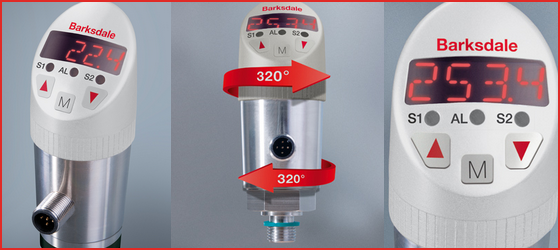|
不同类型的压力开关Different types of pressure switches
在最简单的形式中, 压力开关 是一种能够检测压力变化并在预定水平上打开或关闭电触点的装置。 在这篇文章中, Barksdale 探讨了它们的演变,从机电品种到革命性的固态版本,再到今天的尖端电子压力开关,如 BPS3000。

压力开关分为三个基本类别:机电式、固态式和电子式。 传统上,压力开关一直是机电设备。 然而,今天,固态设备和新型电子压力开关(例如 Barksdale 的 BPS3000 )正在向这项相当古老的技术进军。
机电式压力开关
最常见的机电压力开关 由传感元件和电气快动开关组成。 可以使用许多不同类型的传感元件,但它们有一个共同点:它们会随着系统压力的变化而移动。 通过它们的运动,它们直接作用于快动开关触点的打开和关闭。
差压开关略有不同。 有两个压力端口,一个用于低压侧,另一个用于高压侧。 低压和高压流体作用于同一传感元件。 由于每一侧的表面积相等,因此当压力相等时,开关处于平衡状态。 随着高压侧的压力增加或低压侧的压力降低,活塞向上移动,并在预设的压差下激活快动开关。
开关通常根据所采用的 传感器技术 类型组合在一起。 传感器的特性往往决定了开关的相对精度和寿命。
典型开关类别
膜片开关:使用直接作用于快动开关的焊接密封金属膜片。
- 压力高达 10.43 bar 和真空。
- 重复性 ±1%。
- 低循环率(小于 25 个循环/分钟)。
波登管开关:焊接密封波登管用于驱动快动开关。
- 压力从 3.45 到 1241.06 bar。
- 重复性 ±1%。
- 低循环率(小于 25 个循环/分钟)。
隔膜活塞(Dia-Seal 活塞)开关:作用在活塞上的弹性隔膜,进而
驱动快动开关。
- 压力从真空到 110.32 psi。
- 重复性 ±2%
- 250 万次循环。
活塞开关:O 形环密封活塞直接作用在快动开关上。
- 压力达到 827.37 巴。
- 重复性 ±2%
- 250 万次循环。
固态压力开关
1980 年,Barksdale 推出了第一个 固态压力开关 。 这是一个结合了粘合应变计传感器和双向可控硅开关的简单装置。 如今,固态压力开关种类繁多,具有一到四个或更多开关点、数字显示、模拟和数字输出以及完全可编程性。
在许多情况下,它们跨越了从简单的开关到开环控制器的界限。 除了打开或关闭压力开关电路外,它们还提供比例模拟 4-20 mA 信号或数字输出。 模拟信号可以与 PLC(可编程逻辑控制)、DCS(分布式控制系统)和计算机连接。 主要优势在于循环寿命。 固态开关的使用寿命通常为 1 亿次。
与机电开关相比,固态压力开关具有许多优势,包括:
- 更长的循环寿命。
- 将精度提高到 ±0.5%。
- 高抗冲击和振动。
- 处理各种系统压力的能力。
- 广泛的频率响应。
- 优异的长期稳定性。
BPS3000 电子双压力开关
在开创固态压力开关四分之一个世纪后,Barksdale 推出了下一个改变游戏规则的产品:BPS3000 电子双压力开关。 这种数字压力开关代表了压力开关发展的下一步,并具有一些真正令人印象深刻的属性。

- 测量范围:表压:0 - 9000 psig,绝对压力:0 - 150 psia。
- 外壳等级:4X 型 (IP65) / 6 型 (IP67)。
- 测量范围:0...0.2 bar 至 0...600 bar 表压(可切换到 psi + Mpa)。
- 适合室内或室外使用。
- 最大限度。 2个开关点。
- 模拟输出 4 - 20 mA 或 0 - 10 V。
- 可旋转 320° 显示和电气连接。
- 菜单导航参考 VDMA 标准。
有关 Barksdale 全系列开关产品的更多信息,请联系 010-84282935 或访问 www.barksdaleproducts.com。
Different types of pressure switches
In its simplest form, a pressure switch is a device capable of detecting a pressure change and, at a predetermined level, opening or closing an electrical contact. In this article Barksdale explores their evolution, from electromechanical varieties, through to the revolutionary solid-state version and today's cutting edge electronic pressure switches, like the BPS3000.
Pressure switches fall under three basic classifications: electromechanical, solid state and electronic. Traditionally, pressure switches have been electromechanical devices. Today, however, inroads into this fairly ancient technology are being made by solid-state devices and the new breed of electronic pressure switches, such as Barksdale's BPS3000 .
Electromechanical Pressure Switches
The most common electromechanical pressure switches are composed of a sensing element and an electrical snap-action switch. A number of different types of sensing elements can be used but they have one thing in common: they move in response to changes in the system pressure. Through their movement they directly act on the opening and closing of the snap-action switch's contacts.
Differential pressure switches are slightly different. There are two pressure ports, one for the low pressure side and the other for the high pressure side. The low pressure and high pressure fluids act on the same sensing element. Since the surface areas are equal on each side, the switch is in equilibrium when the pressures are equal. As pressure on the high-pressure side increases, or pressure on the low side decreases, the piston moves up and, at a preset differential pressure, activates the snap switch.
Switches are commonly grouped together based on the type of sensor technology employed. The characteristics of the sensor tend to define the relative accuracy and life one can expect from the switch.
Typical switch categories
Diaphragm Switches: use a weld-sealed metal diaphragm which directly acts on a snap-action switch.
- Pressure up to 10.43 bar and vacuum.
- Repeatability ±1%.
- Low cycle rates (less than 25 cycles/min).
Bourdon Tube Switches: a weld-sealed bourdon tube is used to actuate the snap-action switch.
- Pressure from 3.45 to 1241.06 bar.
- Repeatability ±1%.
- Low cycle rates (less than 25 cycles/min).
Diaphragm Piston (Dia-Seal Piston) Switches: an elastomeric diaphragm acting on a piston which in turn
actuates the snap-action switch.
- Pressure from vacuum to 110.32 psi.
- Repeatability ±2%
- 2.5 million cycles.
Piston Switches: an O-ring sealed piston acts directly on the snap-action switch.
- Pressure to 827.37 bar.
- Repeatability ±2%
- 2.5 million cycles.
Solid-State Pressure Switches
In 1980, Barksdale introduced the first solid-state pressure switch . It was a simple device which combined a bonded strain gage sensor and triac switch. Today, there are a wide variety of solid-state pressure switches that have one to four or more switch points, digital displays, analog and digital outputs, and full programmability.
In many cases they cross the line from being simply a switch to an open-loop controller. In addition to opening or closing the pressure switch circuit(s), they provide a proportional analog 4-20 mA signal or digital output. The analog signal can interface with PLCs (Programmable Logic Controls), DCSs (Distributed Control Systems) and computers. The major advantage lies in cycle life. Solid-state switches routinely have an operational life of 100 million cycles.
Solid-state pressure switches provide a number of advantages over electromechanical switches, including:
- Much longer cycle life.
- Improved accuracy to ±0.5%.
- High resistance to shock and vibration.
- The ability to handle a wide range of system pressures.
- Broad frequency response.
- Excellent long-term stability.
BPS3000 Electronic Dual Pressure Switch
A quarter of a century after pioneering the solid-state pressure switch, Barksdale has introduced the next game-changer: the BPS3000 Electronic Dual Pressure Switch. This digital pressure switch represents the next step in the pressure switch evolution and features some truly impressive attributes.
- Measuring range: gauge: 0 - 9000 psig, absolute: 0 - 150 psia.
- Enclosure Rating: Type 4X (IP65) / Type 6 (IP67).
- Measuring ranges: 0...0.2 bar to 0...600 bar gauge (switchable to psi + Mpa).
- Suitable for indoor or outdoor usage.
- Max. 2 switch points.
- Analogue output 4 - 20 mA or 0 - 10 V.
- Rotatable 320° display & electrical connection.
- Menu navigation refers to VDMA standard.
For more information about Barksdale's full range of switch products please contact 010-84282935
or visit
www.barksdaleproducts.com.
|

